Are you still hanging with me, Steadfast Reader? I’m continuing the amazing and often true saga of my recent cruise to Alaska. I made the trip along with my wife, Jean, and long-time friends, Mike and Brenda Knyght (not their real names). In my previous post, our ship, the MS Hellandam (not its real name either), had just departed Skagway.
I awoke on Day 7 to find the ship in Glacier Bay. At 6:40 am, our location was 58°29’N, 136°03’W, on course 342° at 17.0 knots. Outside the temperature was 43°F with Northerly winds at 8 knots. We had traveled 1,014 nautical miles since departing Vancouver.
The morning fog seemed to be lifting over the calm seas, revealing occasional glimpses of forested land. I looked forward to my imagined version of Glacier Bay, with titanic ice walls dwarfing our ship.
Soon a curtain of fog closed in again. At 8:00 am, we passed Gloomy Knob (what a name!) Over the ship’s PA, they said to look for mountain goats at the Knob, but I saw none.
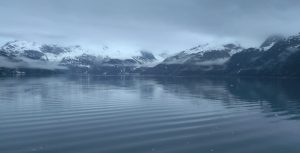
Later, the seas smoothed to a mirror finish, marred by floating chunks of ice. At first, I saw chair-sized chunks, then piano-sized masses, and finally house-sized bergs.
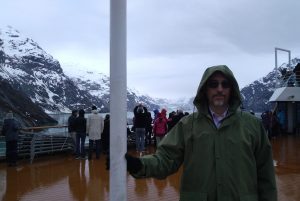
At 9:30, we beheld the magnificent Johns Hopkins Glacier, visible in an inlet cruise ships must not enter. At 10:15 am, we passed the Lamplugh Glacier. Our ship motored slowly and turned so all passengers could get views. Still, fog lingered on this overcast day, with occasional drizzle, dampening some of the effect.
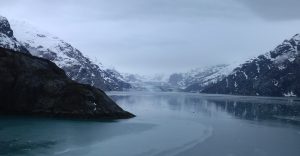
If you go to Glacier Bay, don’t go there saddled with my expectations. The glaciers have been receding since 1750, like a giant hand being pulled back, leaving rocky rubble and watery inlets where the icy fingers had been. You might spot some wildlife, though. Mike claimed he saw otters; and someone aboard sighted a humpback whale fluke.
At 11:45 am, we dressed up, strode to the Pinnacle Grill, and consumed a delightful Mother’s Day brunch of Lobster Eggs Benedict in an elegant atmosphere. It helped assuage the fact that neither Jean nor Brenda could connect with their children on this holiday, due to lack of cell phone reception.
Then a strange thing happened.
Jean and I went back to our cabin to watch glaciers from our verandah. On one of the larger bergs, I pointed out an otter to her. She said she couldn’t see it. I focused my monocular on the animal and let her look, but she said the berg had nothing on it. Gazing at it again, I saw this otter’s head looked human. Not just human, but—fantastically—it changed before my eyes. For a few seconds, its head resembled that of my late Mother; then it took the form of my father-in-law, dead for nearly two decades; finally, it morphed to look like my mother-in-law, who passed last year. The creature then slipped into the water and vanished.
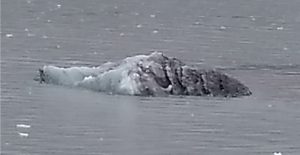
Only then, too late, did I think to grab my camera. I was so astonished, so overcome by intense feelings of grief and remembrance; I couldn’t speak to Jean about those bizarre facial changes.
An explanation, of sorts, came later. At 2:15 pm, Jean and I attended a lecture on Tlingit native culture given by a Huna Cultural Interpreter named Kevin. After the lecture, I privately asked him about Tlingit legends involving otters. He must have sensed something in my query and asked if I’d seen an odd-looking otter. I nodded. He said, “My people tell a legend of the Kooshdakhaa, a half-human, half-otter. Did you see, in this animal’s face, someone you lost?” I nodded again. He said, “The Kooshdakhaa is a shape-shifter, appearing at times of departing. It reflects back feelings of grief, but may also absorb these feelings itself.” I thanked Kevin. I’ll have to admit, I felt better after that.
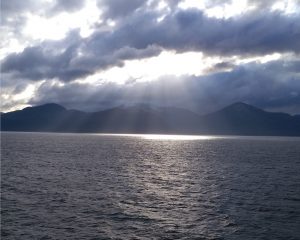
The ship increased speed and headed south, leaving Glacier Bay, bound for Ketchikan. We passed ghostly islands, half-obscured by layers of wispy fog. Jean and I watched the movie musical “The Greatest Showman” in our cabin, then our foursome ate surf and turf in the Main Dining Room. Finally, we played the card game ‘For Sale’ in the Exploration Lounge, which had become a routine for us.
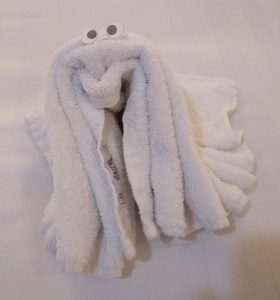
Back in our cabin, we found another example of hand-towel origami—a walrus, I think. With the ship steaming among the many elongated north-south islands between us and Ketchikan, we turned in, while thoughts of shape-shifting half-otters filled the mind of—
Poseidon’s Scribe
